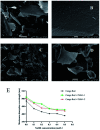Structural characterization, anti-inflammatory and glycosidase inhibitory activities of two new polysaccharides from the root of Pueraria lobata
- PMID: 35492792
- PMCID: PMC9043251
- DOI: 10.1039/d1ra07385k
Structural characterization, anti-inflammatory and glycosidase inhibitory activities of two new polysaccharides from the root of Pueraria lobata
Abstract
Diabetes seriously endangers public health and brings a heavy economic burden to the country. Inflammation is one of the main inducing factors of type-2 diabetes (T2D) and may cause some complications of diabetes, such as diabetic encephalopathy and peripheral neuropathy. In-depth research and development of drugs to cure diabetes and complications are of great significance. Pueraria lobate is a medicinal herb used in several countries to treat many diseases. Here, two new polysaccharides (PLB-1-1 and PLB-1-2) were isolated and purified from the root of Pueraria lobata with molecular weights of 9.1 × 103 Da and 3.8 × 103 Da, respectively. The structure was evaluated by monosaccharide composition, GC-MS and NMR spectroscopy. It was determined that PLB-1-1 comprised →4)-α-d-Glcp-(1→, α-d-Glcp-(1→, →6)-β-d-Galp-(1→, →3)-α-l-Araf-(1→, →3,6)-β-d-Manp-(1→ and →4,6)-β-d-Manp-(1→, and PLB-1-2 consisted of →4)-α-d-Glcp-(1→, β-d-Glcp-(1→, →4,6)-β-d-Glcp-(1→, →3,6)-β-d-Manp-(1→ and α-l-Fucp-(1→. Furthermore, both PLB-1-1 and PLB-1-2 showed anti-inflammatory and inhibitory activities of α-glucosidase and α-amylase in vitro. Therefore, the new polysaccharides, i.e., PLB-1-1 and PLB-1-2, may be considered candidates for the treatment of diabetes and its related complications.
This journal is © The Royal Society of Chemistry.
Conflict of interest statement
The authors declare no conflict of interest.
Figures










Similar articles
-
Two polysaccharides from Rehmannia glutinosa: isolation, structural characterization, and hypoglycemic activities.RSC Adv. 2023 Oct 13;13(43):30190-30201. doi: 10.1039/d3ra05677e. eCollection 2023 Oct 11. RSC Adv. 2023. PMID: 37842674 Free PMC article.
-
Structural features and anti-gastric cancer activity of polysaccharides from stem, root, leaf and flower of cultivated Dendrobium huoshanense.Int J Biol Macromol. 2020 Jan 15;143:651-664. doi: 10.1016/j.ijbiomac.2019.12.041. Epub 2019 Dec 9. Int J Biol Macromol. 2020. PMID: 31821827
-
Isolation, purification, characterization and bioactivities of a glucan from the root of Pueraria lobata.Food Funct. 2018 May 23;9(5):2644-2652. doi: 10.1039/c7fo01921a. Food Funct. 2018. PMID: 29667998
-
Structural characterization of two novel heteropolysaccharides from Catharanthus roseus and the evaluation of their immunological activities.Carbohydr Polym. 2025 Jan 15;348(Pt B):122896. doi: 10.1016/j.carbpol.2024.122896. Epub 2024 Oct 22. Carbohydr Polym. 2025. PMID: 39567132
-
Physicochemical characterization of a polysaccharide from Agrocybe aegirita and its anti-ageing activity.Carbohydr Polym. 2020 May 15;236:116056. doi: 10.1016/j.carbpol.2020.116056. Epub 2020 Feb 22. Carbohydr Polym. 2020. PMID: 32172871
Cited by
-
Valorization of Bioactive Compounds from Two Underutilized Wild Fruits by Microencapsulation in Order to Formulate Value-Added Food Products.Plants (Basel). 2023 Jan 6;12(2):267. doi: 10.3390/plants12020267. Plants (Basel). 2023. PMID: 36678980 Free PMC article.
References
LinkOut - more resources
Full Text Sources
Molecular Biology Databases
Miscellaneous

